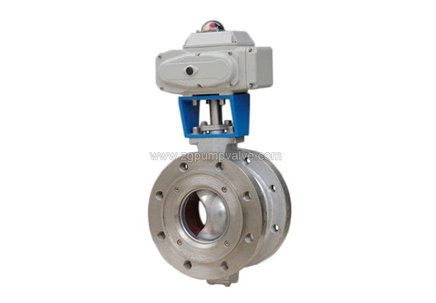Learn - Dec. 13, 2021
There are many types of valves and we often hear about "ball valves". Have you ever wondered what makes a ball valve different from other types of valves? In this blog, we will look at the definition of a ball valve, the benefits of a ball valve, and the different types of ball used in a ball valve.
A ball valve uses a handle to turn the ball in the valve, which has a hole or port in it. The ball is used to allow or stop flow through the valve depending on its position. If the hole is aligned with the pipe, the fluid continues to pass through the valve; if the hole is perpendicular to the pipe, the flow will stop at the valve.
Not all ball valves look the same, some have specific uses, but they all have the same concept. Did you know? A ball valve is considered a ¼ turn valve because it takes a quarter turn to close the valve.

V Type Ball Valve
It is easy to see if it is open or closed. You can easily tell that the valve is open when the handle is aligned with the pipe; when the handle is perpendicular to the pipe, the valve is closed.
Operation after years of non-use is easy. The durability of ball valves allows them to work and completely shut off flow after years of non-use. This gives you added peace of mind.
Fast shut-off. The movement required to operate a 1/4 turn is quick and minimal compared to a gate valve. Water hammer may exist if the flow through the valve is sufficient to cause the line to vibrate when the valve closes quickly and suddenly stops.
A more compact and economical valve. Due to the design of ball valves, they are more compact than gate valves. Gate valves are taller and require more space as the gate needs a place for the fluid to pass through the valve. By using a rotating ball, ball valves are smaller and require less material.
Three different types of the ball can be found in ball valves. For each of these three types, the outside of the ball needs to be smooth and the surface needs to be polished to remove any dents or defects on the surface. As the material cools, the shape may change, resulting in more or less grinding. The three types are hollow, solid, and cored, so let's take a closer look at each of them.
Hollow balls have a cavity that runs from an opening in the bottom of the ball to the top of the stem where it is inserted. Hollow balls require less material to construct, making them more economical, but may require more grinding to allow leaching.
A solid ball is molded into a solid ball that is larger than required to account for any shrinkage and grinding. Solid balls are usually more expensive to manufacture as they require more raw material and grinding to make them perfectly round.
Cored balls are cored through the center, leaving a consistent wall thickness around the entire ball. This ensures that the balls are cooled more evenly, again reducing the amount of grinding required once the balls have cooled completely. These types of balls are becoming increasingly popular due to the cost savings compared to solid balls.
Due to their compact design and ease of use, ball valves are becoming increasingly popular. For the different types of ball valves, there are many options on the market, but all follow the same concept and have many of the same advantages.
If you want to get more information about the ball valves, welcome to contact us today or request a quote.